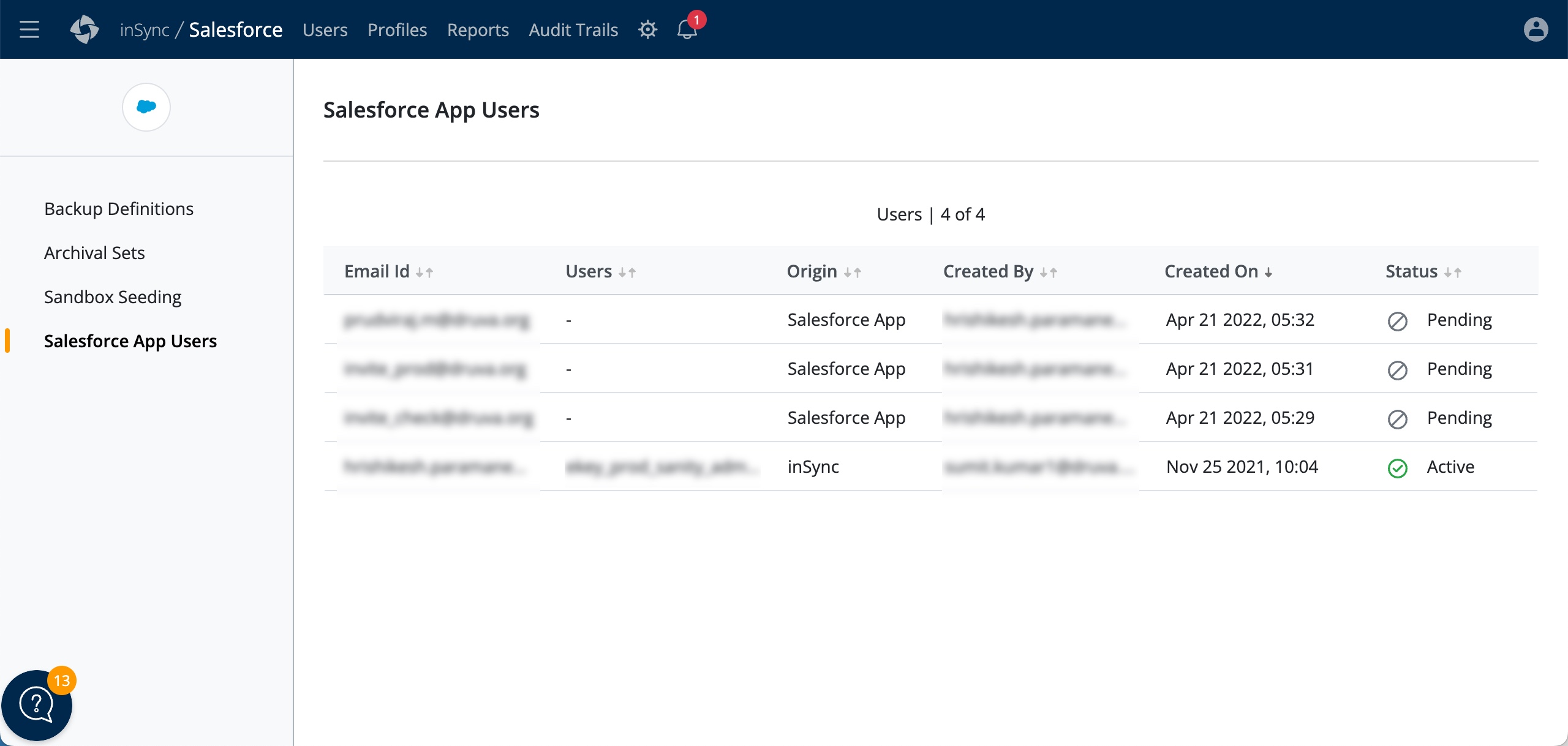Configuring inSync and Deploying the Salesforce App
Before you begin
Ensure the following:
- Review the support matrix to ensure you are using supported Salesforce editions and Clouds. For more information, see Support Matrix.
- Review and complete the prerequisites to install the Salesforce App. For more information, see Prerequisites.
- Ensure you have obtained the required license to configure organizations. For more information, see Licensing Details.
Overview
inSync Cloud administrator and Salesforce App administrator need to complete the following 2-step procedure to configure inSync with the Salesforce App:
Configuring inSync
As an inSync Cloud administrator, perform the following tasks.

| Task | Description |
|---|---|
|
Send invitation for Administrator account creation |
Invite a user from the inSync Management Console to complete the Administrator account creation for the Salesforce App. |
| Configure inSync AD/LDAP Connector or Cloud Key Management System (KMS) | inSync requires the data encryption key to encrypt the backed-up data. Configure inSync AD/LDAP Connector or Cloud Key Management System (KMS) to enable scheduled Salesforce data backup. |
Send invitation for Administrator account creation
- Log in to the inSync Management Console.
- Navigate to Data Protection -> Salesforce.
- Enter a valid corporate email ID to invite a user to create the Salesforce App administrator account.
Note: The inSync Cloud administrator can send multiple invitation emails until one Administrator account is activated from the Salesforce App.
Configure inSync AD/LDAP Connector or KMS
inSync requires the data encryption key to encrypt the backed-up data. You can configure AD/LDAP Connector or Cloud Key Management System (KMS) to generate the data encryption key. For more information, see Configuring inSync AD/LDAP Connector or Configuring Cloud Key Management System (KMS).
Note: To ensure that your data is always encrypted and secure, it is now mandatory to configure inSync AD/LDAP connector or Cloud Key Management (KMS) before you can create the first administrator.
Deploying the Salesforce App
As a Salesforce App administrator, perform the following tasks to deploy the Salesforce App:

| Task | Description |
|---|---|
| Log in | Log in to the Salesforce environment using Salesforce credentials. |
| Install the Salesforce App |
Install the Salesforce App from the Salesforce AppExchange.
For more information about installing the Salesforce App, see Installing the Salesforce App. |
| Activate the administrator account | Provide details received through invitation email and activate the administrator account. |
Installing the Salesforce App
Perform the following steps to install the application in your production or sandbox environment.
- Navigate to the AppExchange listing of the Salesforce App.
If you are using Dell APEX Backup Services, navigate to this AppExchange listing of the Salesforce App.
2. Click Get It Now.
3. Log in to your Salesforce Production environment.
4. Select the type of environment where you want to install the application, which can be Production or Sandbox.
5. Review the installation details and click Confirm and Install.
6. Log in to the Salesforce org where you want to install the application.
7. Choose whether you want to install the application for Admins Only, All Users, or users in specific profiles. Also, you can review the components included in the installation package.
8. Click Install and accept the remote site settings to connect to Cloud.
9. The installation process may take a few minutes. You will receive an email once the installation process is complete.
10. You can access the app through the Salesforce App Launcher.
For further assistance on installing packages from Salesforce AppExchange, see Salesforce Documentation.
Creating Administrator account for the Salesforce App
The inSync Management Console integration with the Salesforce App is complete only after the creation of the Administrator account.
Procedure
- On the Salesforce App console, click User Invitation.
- Enter the user invitation details received through email and click Sign In.
- Confirm your new account password.
Note: The Salesforce App adheres to the following password policy standards.
The minimum password length required is 8 characters.
The maximum password length can be up to 128 characters.
The password must not contain sequences of three or more repeated characters.
The password must contain at least one lowercase letter.
The password must contain at least one uppercase letter.
The password must include at least one number.
The password must include at least one special character.
4. Enter the User Information and click Register.
A default organization, project, and administrator profile are created within your Salesforce App environment. You can use the default organization or switch to another organization from the Settings page.
For more information, see Configuring Salesforce App Settings.
As an inSync Cloud administrator, you can view the Salesforce App users on the inSync Management Console.
Viewing Salesforce App Users on the inSync Management Console
As an inSync Cloud administrator, you can view the Salesforce App users on the inSync Management Console using the following steps.
- Log in to the inSync Management Console.
- Navigate to Data Protection -> Salesforce.
- Select Salesforce App Users.
You can view the Salesforce App users in a table.

Note: The Origin column displays the source where the user was created. The Status column displays Active for the activated Administrator account and displays Pending for the other invited users.

